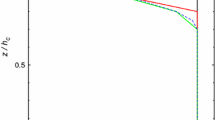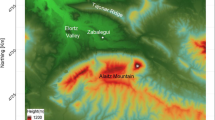Abstract
Source/sink distributions of heat, water vapour andCO2 within a rice canopy were inferred using aninverse Lagrangian dispersion analysis and measuredmean profiles of temperature, specific humidity andCO2 mixing ratio. Monin–Obukhov similarity theorywas used to account for the effects of atmosphericstability on σw(z), the standard deviation ofvertical velocity and τL(z), the Lagrangian timescale of the turbulence. Classical surface layer scaling was applied in the inertial sublayer (z > zruf)using the similarity parameter ζ = (z - d)/L, where z is height above ground, d is the zero plane displacementheight for momentum, L is the Obukhov length,and zruf ≈ 2.3hc, where hc iscanopy height. A single length scale hc, was usedfor the stability parameter 3 = hc/L in the height range 0.25 < z/hc < 2.5. This choice is justified by mixing layer theory, which shows that within the roughness sublayer there is one dominant turbulence length scaledetermined by the degree of inflection in the windprofile at the canopy top. In the absence of theoretical or experimental evidence for guidance,standard Monin–Obukhov similarity functions, withζ = hc/L, were used to calculate the stabilitydependence of σw(z) and τL(z) in the roughness sublayer. For z/hc < 0.25 the turbulence length and time scales are influenced by the presence of the lowersurface, and stability effects are minimal. With theseassumptions there was excellent agreement between eddycovariance flux measurements and deductions from theinverse Lagrangian analysis. Stability correctionswere particularly necessary for night time fluxes whenthe atmosphere was stably stratified.
The inverse Lagrangian analysis provides a useful toolfor testing and refining multilayer canopy models usedto predict radiation absorption, energy partitioningand CO2 exchanges within the canopy and at thesoil surface. Comparison of model predictions withsource strengths deduced from the inverse analysisgave good results. Observed discrepancies may be dueto incorrect specification of the turbulent timescales and vertical velocity fluctuations close to theground. Further investigation of turbulencecharacteristics within plant canopies is required toresolve these issues.
Similar content being viewed by others
References
DePury, D. G. G. and Farquhar, G. D.: 1997, 'simple Scaling of Photsynthesis from Leaves to Canopies without the Errors of Big-Leaf Models', Plant Cell Environ.20, 537–557.
Farquhar, G. D., von Caemmerer, S., and Berry, J. A.: 1980, 'A Biochemical Model of Photosynthetic CO2 Assimilation in Leaves of C3 Species', Planta149, 78–90.
Goudriaan, J. and van Laar, H. H.: 1994, Modelling Crop Growth Processes, Kluwer Academic Publishers, Dordrecht, 238 pp.
Kaimal, J. C. and Finnigan, J. J.: 1994, Atmospheric Boundary Layer Flows: Their Structure and Measurement, Oxford University Press, New York, 289 pp.
Katul, G. G. and Albertson, J. D.: 1999, 'Modeling CO2 Sources, Sinks, and Fluxes within a Forest Canopy, J. Geophys. Res.104, 6081–6091.
Katul, G. G., Leuning, R., Kim, J., Denmead, O. T., and Miyata, A.: 2000, 'Estimating Momentum and CO2 Source/Sink Distribution within a Rice Canopy Using Higher-Order Closure Models', Boundary-Layer Meteorol., in press.
Leclerc, M. Y., Beissner, K. C., Shaw, R. H., den Hartog, G., and Neumann, H. H.: 1990, 'The Influence of Atmospheric Stability on the Budgets of the Reynolds Stress and Turbulent Kinetic Energy within and above a Deciduous Forest', J. Appl. Meteorol.29, 916–933.
Leuning, R.: 1995, 'A Critical Appraisal of Combined Stomatal-Photosynthesis Model for C3 Plants', Plant Cell Environ.18, 339–357.
Leuning, R., Denmead, O. T., Miyata, A., and Kim, J.: 2000, 'source/Sink Distributions of Heat, Water Vapour, Carbon Dioxide and Methane in Rice Canopies Estimated Using Lagrangian Dispersion Analysis', Agric. For. Meteorol., in press.
Leuning, R., Dunin, F. X., and Wang, Y. P.: 1998, 'A Two-Leaf Model for Canopy Conductance, Photosynthesis and Partitioning of Available Energy. II. Comparison withMeasurements', Agric. For. Meteorol.91, 113–125.
Leuning, R., Kelliher, F. M., DePury, D. G. G., and Schulze, E. D.: 1995, 'Leaf Nitrogen, Photosynthesis, Conductance and Transpiration: Scaling from Leaves to Canopies', Plant Cell Environ.18, 1183–1200.
Miyata, A., Leuning, R., Denmead, O. T., Kim, J., and Harazono, Y.: 2000, 'Carbon Dioxide and Methane Fluxes from an Intermittently Flooded Paddy Field', Agric. For. Meteorol., in press.
Raupach, M. R.: 1987, 'A Lagrangian Analysis of Scalar Transfer in Vegetation Canopies', Quart. J. Roy. Meteorol. Soc.113, 107–120.
Raupach, M. R.: 1989a, 'Applying Lagrangian Fluid Mechanics to Infer Scalar Source Distributions from Concentration Profiles in Plant canopies', Agric. For. Meteorol.47, 85–108.
Raupach, M. R.: 1989b, 'A Practical Lagrangian Method for Relating Scalar Concentrations to Source Distributions in Vegetation Canopies', Quart. J. Roy. Meteorol. Soc.115, 609–632.
Raupach, M. R., Finnigan, J. J., and Brunet, Y., 1996, 'Coherent Eddies and Turbulence in Vegetation Canopies: The Mixing-Layer Analogy', Boundary-Layer Meteorol.78, 351–382.
Sellers, P. J.: 1985, 'Canopy Reflectance, Photosynthesis and Transpiration', Int. J. Remote Sens.6, 1335–1372.
Shaw, R. H.; den Hartog, G., and Neumann, H. H.: 1988, 'Influence of Foliar Density and Thermal Stability on Profiles of Reynolds Stress and Turbulence Intensity in a Deciduous Forest', Boundary-Layer Meteorol.45, 391–409.
Stanhill, G.: 1969, 'A Simple Instrument for the Field Measurement of Turbulent Diffusion Flux', J. Appl. Meteorol.8, 509–513.
Wang, Y. P. and Leuning, R.: 1998, 'A Two-Leaf Model for Canopy Conductance, Photosynthesis and Partitioning of Available Energy. I. Model Description', Agric. For. Meteorol.91, 89–111.
Author information
Authors and Affiliations
Rights and permissions
About this article
Cite this article
Leuning, R. Estimation of Scalar Source/Sink Distributions in Plant Canopies Using Lagrangian Dispersion Analysis: Corrections for Atmospheric Stability and Comparison with a Multilayer Canopy Model. Boundary-Layer Meteorology 96, 293–314 (2000). https://doi.org/10.1023/A:1002449700617
Published:
Issue Date:
DOI: https://doi.org/10.1023/A:1002449700617




